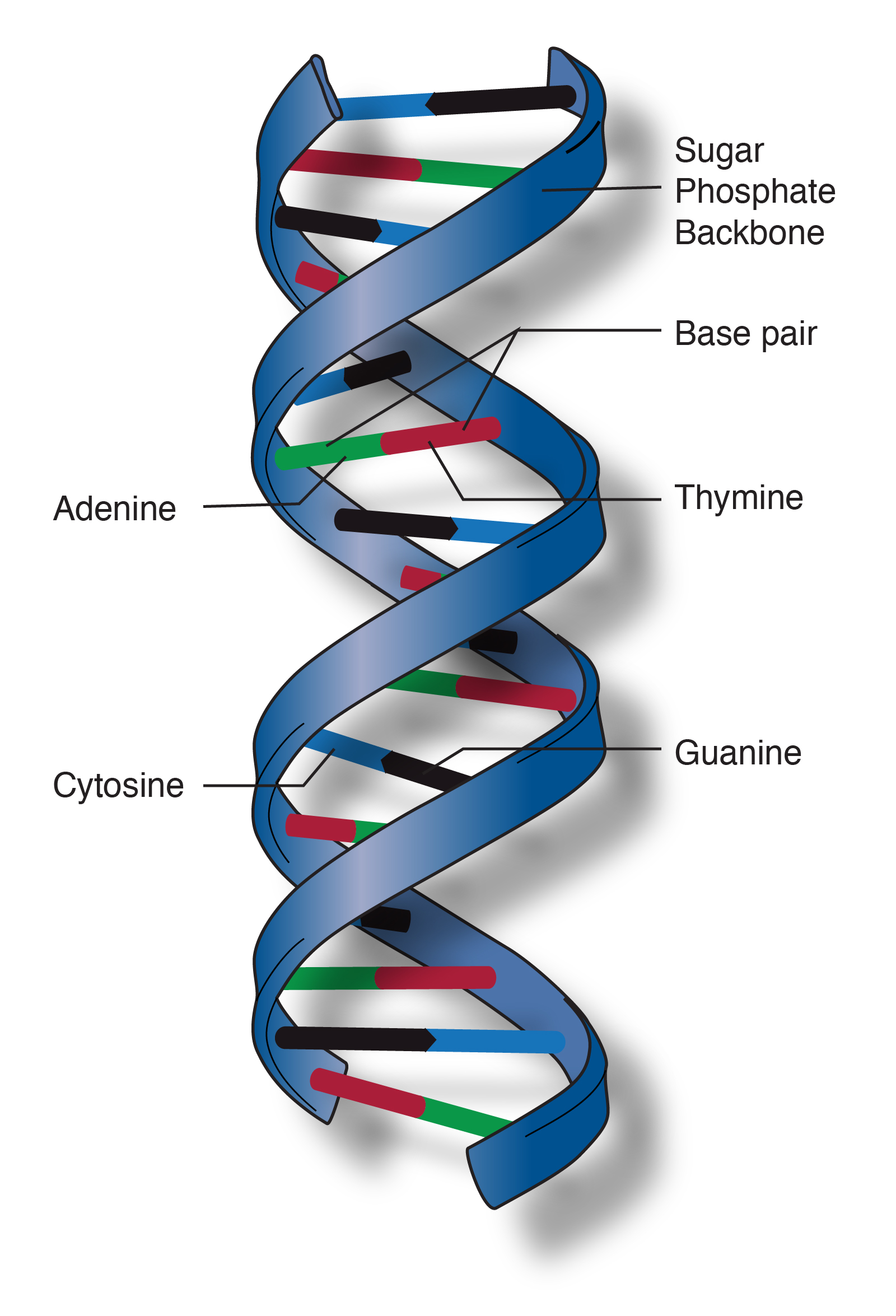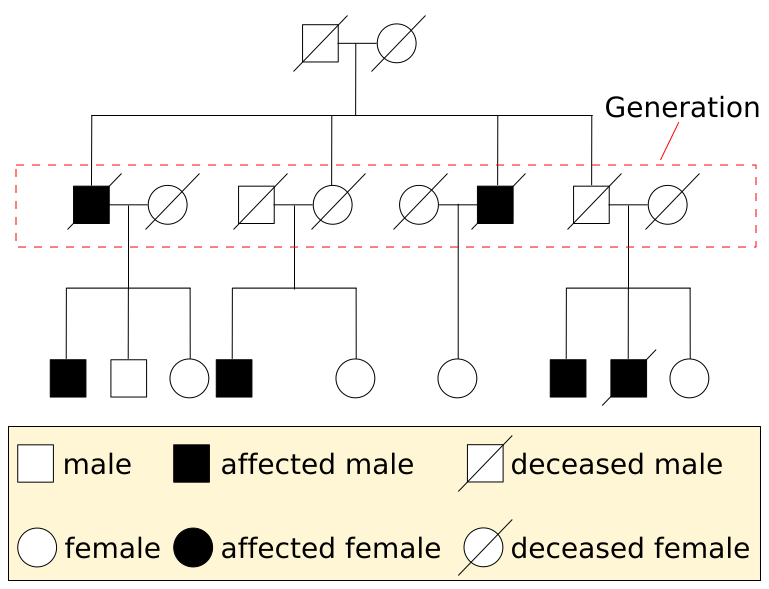Science - Biology Year 10
Definitions
- Chromosome: Structure in the nucleus of a cell, composed of DNA
- DNA: A double helix structure made of nucleotides
- Deoxyribose sugar: one of the three nucleotides of DNA
- Gene: a section of DNA that carries the code for a particular characteristic
- Nitrogenous base: part of a nucleotide, four types: ademine, thymine, guanine and cytocine
- Nucleotide: the building blocks of DNA, composed of a Deoxyribose sugar, Nitrogenous base and phosphate
- Phosphate: one of the components of a nucleotide
- Trait: a characteristic inherited by an organism
- Autosome: all chromosomes other than sex chromosomes
- Centromere: point where the two chromatids join together
- Chromatid: one of the strands of a chromosome following replication
- Diploid Number: number of chromosomes in the cell of an organism, represented as
- Gamete: sperm or egg cell
- Haploid Number: number of chromosomes in the gametes of an organism, represented as
- Homologous Chromosomes: chromosomes with genes for particular characteristics at the same location
- Meiosis: A type of cell division where gametes are produced
- Mitosis: A type of cell division that produces two daughter cells which are identical to the parent cell
- Allele: Different forms of the same gene located at the same point of homologous chromosomes
- Dominant Allele: allele for a trait that is observed in the outward appearance when the trait is heterozygous
- Genotype: genetic information carried by an individual
- Heterozygous: having two different alleles on homologous chromosomes
- Homozygous: having two identical alleles on homologous chromosomes
- Mutation: the alteration of the nucleotide sequence in the genome of an organism
- Phenotype: observable characteristic dictated by the genotype
- Recessive Allele: allele for a trait that is hidden in the outward appearance when the trait is heterozygous
- Genome: genetic information carried by a haploid set of chromosomes
- Single Nucleotide Polymorphism (SNP): difference of only one base pair between two organisms
Fossils
- A fossil is evidence of past life.
- Fossils can be part of an organism, such as its bones, teeth, feathers, scales, branches or leaves.
- Fossils can also be traces, such as footprints, burrows and other evidence that an organism existed in an area.
- Fossils provide evidence that life has changed over time. Some life forms that used to exist on Earth no longer exist.
- Studying the fossil record also provides evidence that life forms have become more complex over time.
- The study of fossils is called Palaeontology.
Major Milestones in the History of Life
- Ice Ages
- Cambrian Explosion
- Photosynthesis
- Merger between mitochondria and anaerobic organisms
- Formation of the KT Boundary (Extinction of the dinosaurs)
- Motion of tectonic plates
- Land animals developing eggs
- Animals moving onto Land
Formation of life on Earth
- Planet Earth forms
- Core and Crust forms
- First Oceans
- First Life (Cyanobacteria or Archea)
- Oxygen accumulates in the atmosphere
- First Animals
- First Vertebrates (Fish)
- First land plants
- Dinosaurs
- Dinosaurs go Extinct
- Humans
Theory of evolution
- All life on Earth shares a common ancestor.
- All the different species on Earth underwent mutations in the past to better suit their environment.
- Evolution (Not Theory of Evolution) means “descent with modification”
- Darwin’s Theory of Evolution states that all life shares a common ancestor, and that the differences between life forms is explained by Survival of the Fittest
Natural Selection
- Natural selection is the concept of survival of the fittest.
- There are 4 conditions for natural selections: variation between individuals, heredity, reproduction and variation of fitness
- Selective pressures are phenomena that impact on an organism’s fitness
Stages of Natural Selection
1. Isolation
- A species becomes separated by an environmental factor e.g. formation of a river
2. Variation
- A mutation occurs in one of the isolated groups
3. Selection
- If the mutation improves fitness, the mutation is passed on to the next generation
4. Speciation
- After several generations, the isolated group has a majority of individuals carrying the mutation, and these individuals are considered to have evolved.
Law of Superposition
- Because upper layers are younger than the ones beneath them, the law of superposition states that a fossil’s age can be determined by the age of fossils around them. This only applies to UNDISTURBED rock.
- Relative age: age of the fossil based on the Law of Superposition, e.g. Fossil A is older than Fossil B but younger than fossil C.
- Absolute age: the actual age of the fossil, e.g. Fossil A is 6000 years old.
Analysing the Fossil record
- Faulting can cause projections of rock through other layers.
- Folding results in layers of rock being moved away from each other.
Why are fossils important?
- Fossils allow us to determine early biodiversity
- Fossils can be compared to modern day organisms
- Fossils improve our understanding of previous conditions on Earth
- Fossils support our estimates for the age of the Earth
- Fossils provide evidence for Evolution
- Fossils provide evidence of continental drift
Mitosis
- Mitosis is the process by which one parent cell splits into two identical daughter cells.
- Mitosis is the most common method of reproduction for single-celled organisms.
- There are 5 main stages of mitosis:
- Prophase: number of chromosomes in the cell double up
- Metaphase: chromosomes wind up and align along the equator of the cells
- Anaphase: Chromatids (Not Chromosomes, this is explained later) are drawn towards the ends of the cell by spindle fibers
- Telophase: Cell nuclei forms, chromosomes form and unwind
- Cytokinesis: Cell splits into two, completing the process of mitosis
- In the human body, all cells other than sex cells (sperm and ova) are generated through mitosis.
DNA
- DNA stands for DeoxyriboNucleic Acid
- DNA takes the shape of a Double Helix

- The DNA molecule is made up of repeating components known as NUCLEOTIDES
- Each nucleotide has three components:
- A sugar
- A Phosphate
- One of four nitrogenous bases:
- A - Ademine
- T - Thymine
- G - Guanine
- C - Cytocine
- Adenine (A) can only pair with Thymine (T), while Guanine (G) can only pair with Cytocine (C)
- DNA contains all the instructions to make POLYPEPTIDES (Proteins)
- The nitrogenous bases bond with each other via hydrogen bonds
- DNA is read in groups of three, known as CODONS or TRIPLETS
Mutations
A MUTATION is the alteration of the nucleotide sequence in the genome of an organism
A MUTAGEN is a physical or chemical agent that changes the genetic material (Usually DNA) of an organism, increasing the frequency of
- Most mutations are harmless (neutral)
- Mutations that IMPROVE survivability are known as BENEFICIAL MUTATIONS
- Mutations that DECREASE survivability are known as DETRIMENTAL MUTATIONS
Punnett Squares
- Chromosomes contain genes, which dictate traits
- An Allele is any of the possible forms of a gene, e.g. Tall/short
- Alleles tend to be either Dominant or Recessive. Dominant alleles are represented by a capital letter, while recessive alleles are represented by the same letter, but lower case.
- Every chromosome pairs up with another chromosome. The alleles in each pair of chromosomes dictates the properties of the organism. One chromosome is inherited from the organism’s male parent, while the other is inherited from the female parent.
- When an organism has a pair of Homozygous Alleles, both chromosomes for that trait have the same allele (Both Dominant or both recessive)
- When an organism has Heterozygous Alleles, one chromosome has the Dominant allele, while the other has the recessive allele. An organism with Heterozygous Alleles will display the characteristics of the Dominant Allele.
- A Punnett square is a graphical representation of the chances of an organism having a specific trait.
- In the image above, yellow coloring is the dominant allele, while green coloring is the recessive allele.
- The yellow parent in the image is Heterozygous for the color trait, while the green parent is Homozygous Recessive for the color trait.
- The chart shows that there is a 50% chance of a heterozygous plant, and a 50% chance of a homozygous recessive plant.
- Punnett squares can be used for many visible traits (handedness, curly/straight hair, ability to roll tongue, detached earlobes), while other traits, such as some genetic diseases, require more in-depth methods.
Pedigree Charts
- A pedigree chart is a diagram that shows the occurence and appearance of phenotypes of a particular gene from one generation to the next.

- Pedigree charts can be used to find the presence or absence of traits in a bloodline (e.g. CCR-5:Δ32 HIV Immunity)